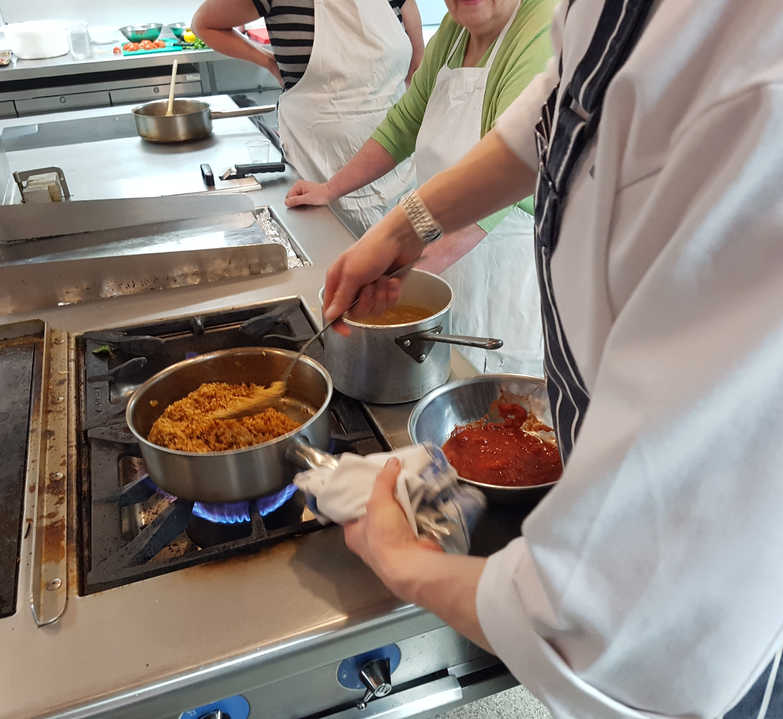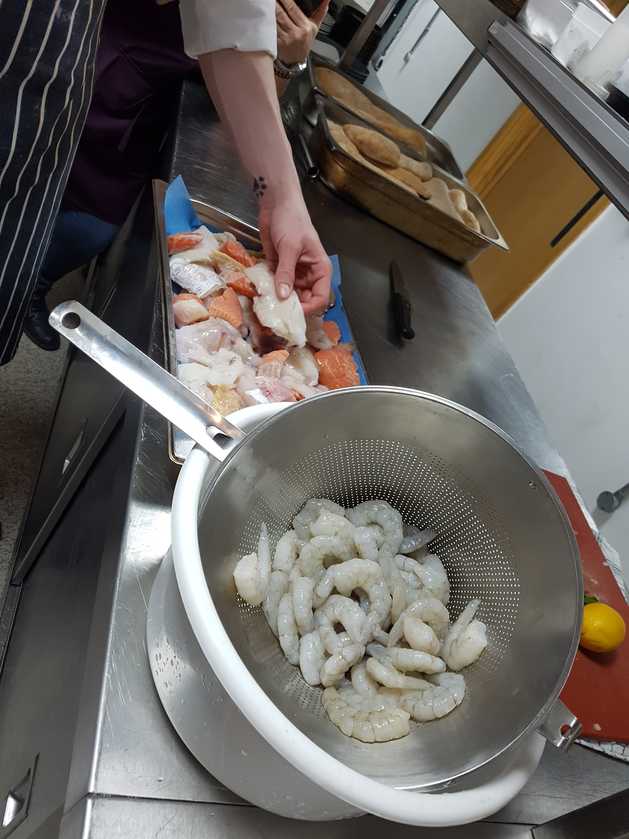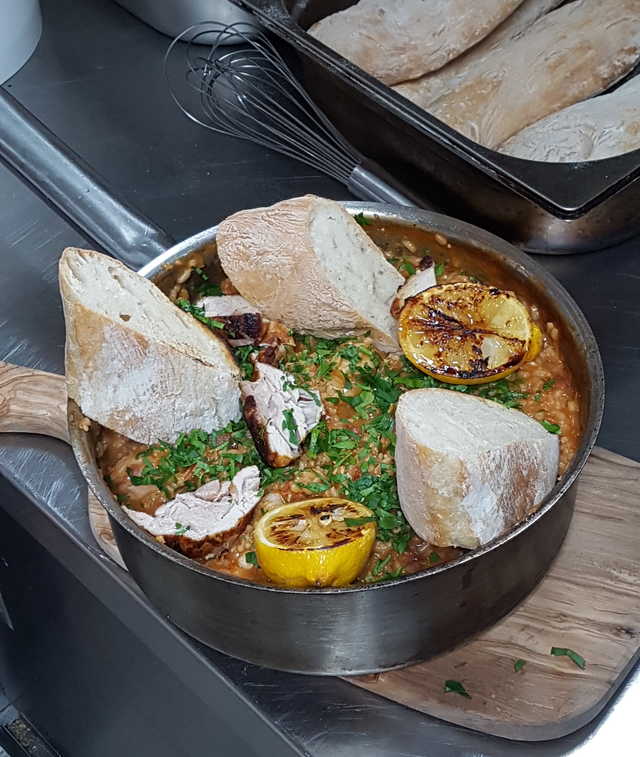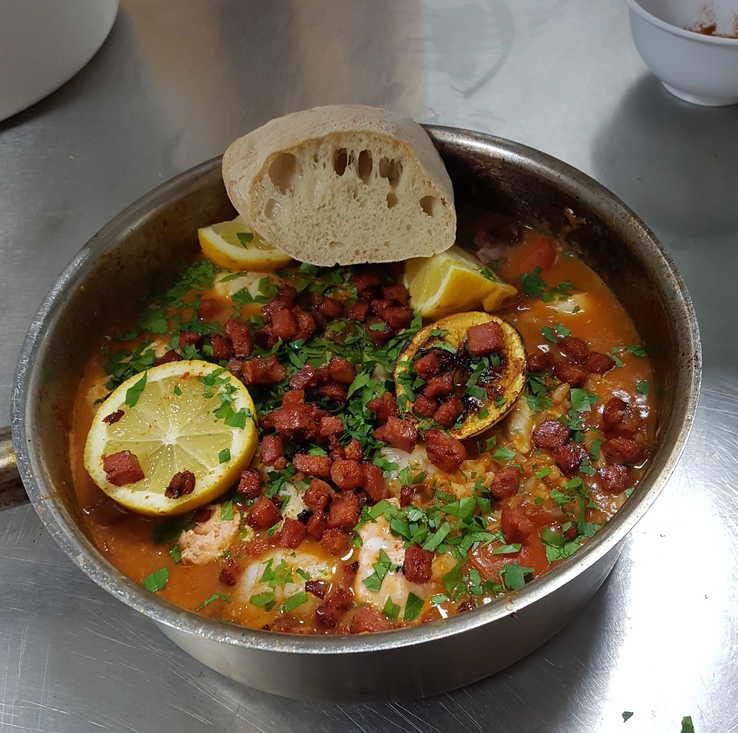Culinary Masterclass - British Paella
The thing to know about Spaniards, particularly Valencians, is that they are ridiculously precious about their paella.
It doesn't make a whole lot of sense since you can be sure that since Africans began cultivating rice 3,000 years ago they've been happily frying it up for dinner with the stuff they've dug up or killed that day. So making a big song-and-dance about Arroz con Cosas (rice 'n' stuff), even going so far as making it your national dish, seems overkill.
Just don't tell that to a Spaniard!
The history of Valencian paella, reputedly the first and original Spanish paella, goes back at least as far as the first published recipe in 1840.
Before this it was certainly being made by rice-picking peasants around the Albufera lagoon near the Mediterranean port of Valencia in Eastern Spain. They would cook up rice for lunch in a large, flat, easily-transported frying pan called, suspiciously, a paella, adding any meat they could catch, and any vegetables they could find - mostly beans.
Apparently they ate quite a lot of eels, snails and water voles this way.
Once the region began prospering in the late 19th Century, the dish became more of a family meal or a large weekend feast and began incorporating more rabbit, duck and chicken.
As Spain developed into a 1960's tourist trap, the dish was progressively adopted by travel agents and food snobs who established ludicrously limiting rules on what should be allowed in an authentic paella Valenciana.
These are now restricted to precisely 10 ingredients:
Despite the fact that the original peasant dish would definitely have used sausage, chorizo, or anything else edible the farm labourers could get their filth-encrusted hands on, these days if you publish a recipe for paella with chorizo in it - you might just end up featuring on the Spanish evening news.
And not in a good way - just ask Jamie Oliveoil.
Fortunately, even the most ardent Spanish paella fans allow a certain degree of leeway for non-Valencian forms, especially for paella do marisco (seafood). Which is almost certainly as old a recipe as the original amongst coastal fishing communities. And quite possibly even more popular and well-known.
More-or-less any kind of seafood seems to be used - squid, lobster, mussels, clams, prawns, though not fish.
Still, most everyone agrees on some basic paella cooking principles:
If you want to add decorative elements to the surface of the paella for serving, it might be best to par-cook them first, though you should get away with laying a few quickly-cooking raw prawns on top.
You don't really want to cover the dish lest the rice goes mushy and sticky (except for a 10 minute final rest with a towel). You can, however, stick the whole pan in the oven for a while to sufficiently cook the upper parts - since it's hard to re-create the effect of a burning wood fire in your kitchen.
Aaron eschews tradition and here and takes a typical chicken and seafood paella mixta (mixed paella) recipe but then adds insult to injury with both chorizo and fish.
I chose prawns, salmon and monkfish from the varied selection on offer for my arroz con cosas (rice and things).
Let's hope the Spanish never hear of it!
It doesn't make a whole lot of sense since you can be sure that since Africans began cultivating rice 3,000 years ago they've been happily frying it up for dinner with the stuff they've dug up or killed that day. So making a big song-and-dance about Arroz con Cosas (rice 'n' stuff), even going so far as making it your national dish, seems overkill.
Just don't tell that to a Spaniard!
The history of Valencian paella, reputedly the first and original Spanish paella, goes back at least as far as the first published recipe in 1840.
Before this it was certainly being made by rice-picking peasants around the Albufera lagoon near the Mediterranean port of Valencia in Eastern Spain. They would cook up rice for lunch in a large, flat, easily-transported frying pan called, suspiciously, a paella, adding any meat they could catch, and any vegetables they could find - mostly beans.
Apparently they ate quite a lot of eels, snails and water voles this way.
Once the region began prospering in the late 19th Century, the dish became more of a family meal or a large weekend feast and began incorporating more rabbit, duck and chicken.
As Spain developed into a 1960's tourist trap, the dish was progressively adopted by travel agents and food snobs who established ludicrously limiting rules on what should be allowed in an authentic paella Valenciana.
These are now restricted to precisely 10 ingredients:
- rice
- water
- salt
- olive oil
- chicken
- rabbit
- garrofo beans (a kind of large lima or butter bean)
- ferradura beans (flat green beans that are a specialty of Valencia)
- tomato (usually grated fresh tomatoes)
- saffron
Despite the fact that the original peasant dish would definitely have used sausage, chorizo, or anything else edible the farm labourers could get their filth-encrusted hands on, these days if you publish a recipe for paella with chorizo in it - you might just end up featuring on the Spanish evening news.
And not in a good way - just ask Jamie Oliveoil.
Fortunately, even the most ardent Spanish paella fans allow a certain degree of leeway for non-Valencian forms, especially for paella do marisco (seafood). Which is almost certainly as old a recipe as the original amongst coastal fishing communities. And quite possibly even more popular and well-known.
More-or-less any kind of seafood seems to be used - squid, lobster, mussels, clams, prawns, though not fish.
Still, most everyone agrees on some basic paella cooking principles:
- Use a short-grain Valencian paella rice cooked with about 3 times the volume of liquid, added all at once.
- Cook it in a fairly thin layer (less than an inch deep) in a large, flat pan.
- Do not stir the paella as it simmers - you're not making risotto.
If you want to add decorative elements to the surface of the paella for serving, it might be best to par-cook them first, though you should get away with laying a few quickly-cooking raw prawns on top.
You don't really want to cover the dish lest the rice goes mushy and sticky (except for a 10 minute final rest with a towel). You can, however, stick the whole pan in the oven for a while to sufficiently cook the upper parts - since it's hard to re-create the effect of a burning wood fire in your kitchen.
Aaron eschews tradition and here and takes a typical chicken and seafood paella mixta (mixed paella) recipe but then adds insult to injury with both chorizo and fish.
I chose prawns, salmon and monkfish from the varied selection on offer for my arroz con cosas (rice and things).
Let's hope the Spanish never hear of it!
menu
Paella Mixta
main meat fish spanish
Aaron spiced up this basic (and already hopelessly inauthentic) BBC Good Food
paella de marisco recipe
by adding cayenne, removing the thyme (thyme!) and adding chicken and chorizo.
Serves 4
Ingredients
- 1 tblsps olive oil
- 1 onion, chopped
- 3 tomatoes
- 1 tsp paprika
- 1 tsp thyme nope
- 1 tsp cayenne pepper or definitely less!
- 300g paella or risotto rice
- 100ml white wine or dry sherry
- 400g can chopped tomatoes with garlic
- 5 king prawns
- 900ml chicken stock
- handful seafood mix
- 1 lemon, ½ juiced, ½ cut into wedges
- handful of flat-leaf parsley, roughly chopped
- 50g chorizo
- 2 chicken thighs
To Serve:- ciabatta, sliced
- wooden dining spoons
Heat the olive oil in a large frying pan or wok.
Add the smoked paprika, thyme, cayenne to taste, and paella rice, stir for 1 min, then splash in the wine or sherry, if using. Once evaporated, stir in the chopped tomatoes and chicken stock.
Season and cook, uncovered, for about 15 mins, stirring now and again until the rice is almost tender and still surrounded with some liquid.
Squeeze over the lemon juice, scatter over the parsley and serve with the lemon wedges.
Traditionally eaten with a wooden spoon!
Add the smoked paprika, thyme, cayenne to taste, and paella rice, stir for 1 min, then splash in the wine or sherry, if using. Once evaporated, stir in the chopped tomatoes and chicken stock.
Season and cook, uncovered, for about 15 mins, stirring now and again until the rice is almost tender and still surrounded with some liquid.
Add the roast chicken thighs to the pan together with the reserved chorizo pieces.
Either scattered on top or stirred through the rice.
Stir in the seafood mix or place elegantly on top and cover with a lid.
Simmer for 5 mins, or until the seafood is cooked through and the rice is tender.Squeeze over the lemon juice, scatter over the parsley and serve with the lemon wedges.
Traditionally eaten with a wooden spoon!
Well, I'm not sure it deserves the title paella but it doesn't taste too bad.
I don't really think the lemon works here even though it is typical - I prefer it served with aïoli.
I don't really think the lemon works here even though it is typical - I prefer it served with aïoli.




Chop the chorizo into ½" cubes and fry until the oil cooks out and the chorizo begins to colour. Remove with a slotted spoon and set the meat aside.